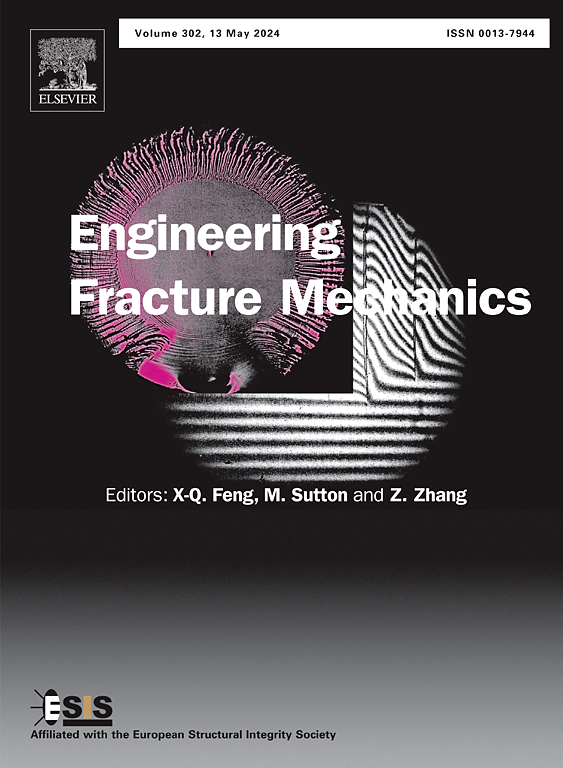利用三维围岩动力学-离散元耦合方法研究岩石颗粒破裂:强调局部表面特征
IF 4.7
2区 工程技术
Q1 MECHANICS
引用次数: 0
摘要
岩基颗粒介质中的单个颗粒破碎会深刻影响组合体的整体宏观尺度行为,颗粒形态和表面特征对强度有显著影响。然而,广泛使用的数值方法往往会过度简化现实形态,从而导致不切实际的颗粒破碎模拟。本研究通过专门研究局部表面几何形状对颗粒强度和断裂模式的影响,解决了这一局限性。研究使用粒子的 X 射线计算机断层扫描(CT)图像来获取真实的几何形状,并引入了 Voronoi 平行线枚举(VPLE)这一形态保留表面生成策略来捕捉复杂的表面特征。提出了一种周动力学-离散元耦合框架,用于模拟基于岩石的单个聚集体的破碎。该数值框架通过巴西玄武岩岩心测试进行了验证,并与其他有限离散元方法进行了严格比较。研究探讨了颗粒形态的不同极端,考虑了破碎模拟中凹面的存在和不存在。在断裂过程中,采用了强大的计算几何管道来测量接触面积和局部曲率半径。研究结果表明,凹面特征以及接触曲率大大降低了颗粒强度(≈40%),而凸面颗粒则表现出更高的强度。尖锐表面特征的存在导致了多种失效机制,包括最初的表面破碎和随后的分裂失效。本研究成果有力地强调了在对发生破碎的颗粒材料进行数值模拟时考虑现实颗粒几何形状的重要性。本文章由计算机程序翻译,如有差异,请以英文原文为准。
Investigating rock particle breakage using 3D coupled peridynamics-discrete element method: Emphasis on local surface features
Individual particle breakage within rock-based granular medium profoundly influences the overall macro-scale behavior of the assembly, with the strength being notably impacted by particle morphology and surficial features. However, the widely used numerical methods often oversimplify the realistic morphology, resulting in unrealistic particle breakage simulations. The current study addresses the limitation by specifically investigating the influence of local surface geometry on particle strength and breakage patterns. X-ray Computed Tomography (CT) images of particles were used to obtain the realistic geometry and Voronoi Parallel Linear Enumeration (VPLE), a morphology-preserving surface generation strategy was introduced to capture the complex surficial features. A coupled peridynamics-discrete element framework was proposed to simulate the breakage of individual rock based aggregates. The numerical framework was validated with Brazilian tests on basalt rock cores, and a rigorous comparison was made against other finite-discrete element methods. The study explores different extremes of particle morphology, considering the presence and absence of concavities in the breakage simulations. Robust computational geometry pipeline was employed to measure contact area and local radius of curvature during the breakage. The findings highlight that the concave features, along with the contact curvature significantly reduce the particle strength () as opposed to the convex particle variants exhibiting higher strength. The presence of sharp surficial features led to multiple failure mechanisms, including initial asperity crushing and subsequent splitting failure. The present work strongly emphasizes the importance of considering realistic particle geometry in numerical simulations of granular materials undergoing crushing.
求助全文
通过发布文献求助,成功后即可免费获取论文全文。
去求助
来源期刊
CiteScore
8.70
自引率
13.00%
发文量
606
审稿时长
74 days
期刊介绍:
EFM covers a broad range of topics in fracture mechanics to be of interest and use to both researchers and practitioners. Contributions are welcome which address the fracture behavior of conventional engineering material systems as well as newly emerging material systems. Contributions on developments in the areas of mechanics and materials science strongly related to fracture mechanics are also welcome. Papers on fatigue are welcome if they treat the fatigue process using the methods of fracture mechanics.

 求助内容:
求助内容: 应助结果提醒方式:
应助结果提醒方式:


